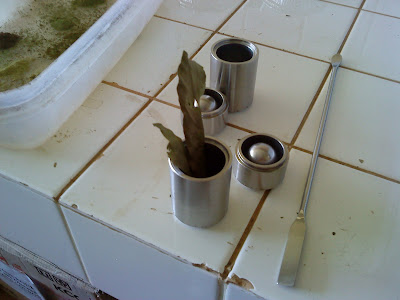One way to describe a forest around here would be to say “It is characterized by this tree, and this tree…and these 600 other species as well”. It’s grindingly specific. Alternatively, by measuring traits of those 600 species one can say things like, “this forest is characterized by trees with higher/lower than average wood density” or “trees in this area are particularly efficient at grabbing Nitrogen”. Some of this is purely academic but bits can also used to demonstrate that say, a forest established after logging has lower wood density and therefore traps less carbon than the forest that it is replacing; a decent argument for conservation or at least for a modification of current practices. Much of the trait-work is done on a macro level – measuring bark thickness, chlorophyll content, etc. Nutrient analysis on the other hand is done on the micro-level and requires a chunk of lab-time.
For the nutrient analysis leaves are dried and then crumbled and crammed into metal cylinders the size of shot glasses.
Each cylinder is loaded with a metal ball the size of a pinball and then sealed up. A pair of these cylinders are loaded into a machine which rattles away at 24 times per second for two minutes. After this rapidfire pounding, the leaf is reduced to a powder.
The bulk of the powder is transferred to little eppendorf tubes. The rest joins the pile of every-shade-of-green...or is used as eyeshadow.
BTW. The foot is way better. With a little convincing it can now be squeezed into my Croc and I can keep it a little below waist-level. I’m getting around crutchless with minimal limp.
I probably should have mentioned in the previous post that very few people die from Bothrops bites. Wiki says that they kill more folks than any other reptile in the Americas, but that’s mostly a function of the frequency of encounters. They’re just really common. (The team saw two others last week). The mortality rate is in fact way low. The title of "Most Dangerous Reptile" also has much to do with Bothrops’ attitude. They don’t budge. They’re of the opinion that there’s no reason they should move for you, and they’re right. That’s all well and good if you see them, but they’re pretty cryptic when they are not moving; the ground is always a collage or brown and Bothrops is as well.
Case in point: last week Chris started to bend down to collect a root sample. Seth pointed out there was a Bothrops coiled around the base. Yikes.







No comments:
Post a Comment